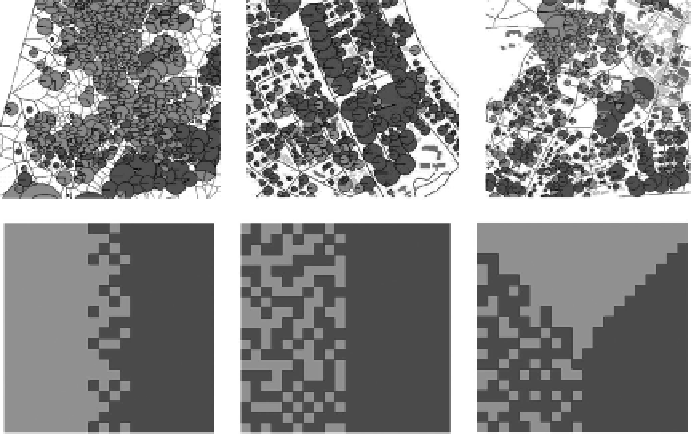Geoscience Reference
In-Depth Information
on average, once every few years, a reasonable rate of occasional migration for a time step of several
months, should be at a level of 0.01-0.03 per time step.
Thomas Schelling investigated his model with 23 white and 22 black agents on a standard
8 × 8 chessboard and employed sequential updating (Schelling, 1971). In the following, we will
also follow a sequential updating approach and assume that an agent moves immediately after
the decision is made and all other agents become immediately aware of its move. The order of
updating is random in all examples and established anew at every time step. The probability
of occasional migration m is 0.01. An agent observes the entire urban space and decides on its
future location before moving to it, independently of the distance between the current and future
location.
9.3.4 q
ualitatiVe
V
iew
of
the
S
chelling
M
odel
d
ynaMicS
and
c
ollectiVe
P
henoMena
The goal of the Schelling model is to explain urban segregation patterns based on an individual's ten-
dency to reside among friends. As Schelling discovered in 1971, the initial random pattern remains
random (Figure 9.5a) over time if the agents can be satisfied with two friends within a 3 × 3 neigh-
bourhood. However, if agents search for neighbourhoods with three or more friends, then the city
residential pattern becomes clustered over time (Figure 9.5b). That is, in Schelling's experiments,
F
crit
is between 2/8 = 0.25 and 3/8 = 0.375. Thomas Schelling recognised this emergent phenomenon
by eye, playing with the pawns on a chessboard. Visual inspection, however, is insufficient for the
systematic study of the model patterns. Segregation indices, for example, Moran's
I, a measure of
spatial autocorrelation, may be useful here (Hatna and Benenson, 2011).
Real-world residential patterns cannot be limited to only random or segregated. Figure 9.7 pres-
ents residential patterns of Jews and Arabs in the Yaffo area of Tel Aviv and their abstract counter-
parts. Is the Schelling model able to generate these patterns? In the following, we will demonstrate
that the answer to this question is affirmative and that Schelling model dynamics are much richer
than simple convergence to pure integrated or segregated patterns.
FIGURE 9.7
Three residential patterns of Arab-Jews in the Yaffo residential area of Tel Aviv and their
abstract counterparts. (From Hatna, E. and Benenson, I., Geosimulation of income-based urban residen-
tial patterns, in:
Advanced Geosimulation Models
, Marceau, D. J. and Benenson I., eds., Bentham Science
Publishers, Hilversum, the Netherlands, pp. 111-125, 2011.)

